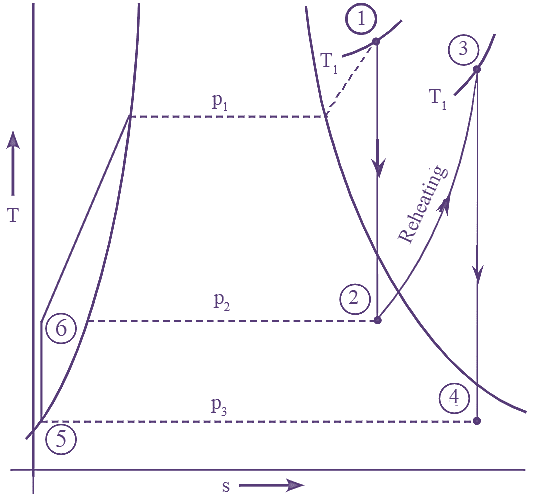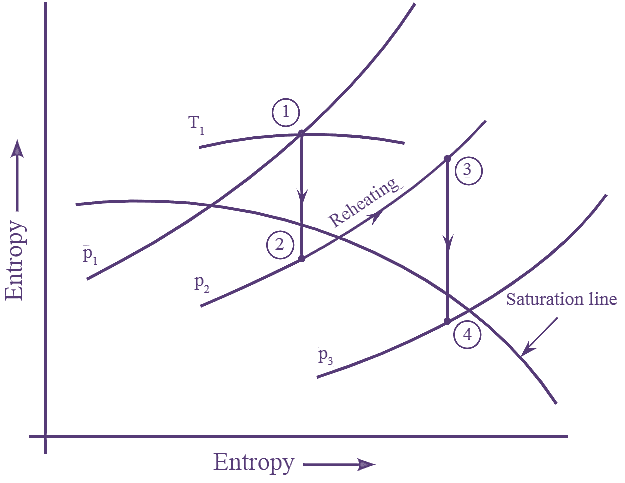The efficiency of Rankine cycle can also be increased by reheating the steam. In reheat cycle, the steam in the turbine is expanded in number of stages. After partial expansion of steam in high pressure turbine, it is reheated to the initial temperature at constant pressure in reheated. This reheated steam is further expanded in low pressure turbines. The process of reheating is shown in figure (1).

Figure 1: Reheat Cycle.
T-s and h-s Diagrams of Reheat Cycle:

Figure 2: T-s Diagram.

Figure 3: h-s Diagram.
In a reheat cycle the steam in a superheated state at point- 1 expands isentropically while flowing through the turbine, as shown by the vertical line in figure 2. After expansion, the steam becomes wet. Which is reheated at a constant pressure (generally upto the same temperature as that at point- 1) shown by the point-3, where it is superheated. The steam again expands isentropically while flowing through the next stage of the turbine, as shown by the vertical line 3 to 4 in h-s diagram (see Figure 3).
Salient Points
- Steam entering into the turbine.
- Steam condition after partial expansion; (point where reheating starts).
- Steam condition after reheating.
- Steam condition after expansion in turbine.
Efficiency of Reheat Cycle
Efficiency of reheats Rankine cycle is given as.
\[{{\eta }_{\text{Reheat}}}=\frac{Workdone}{Total\text{ }heat\operatorname{s}upplied}\]
Workdone = Turbine work + Pump work
\[{{W}_{T}}=({{h}_{1}}-{{h}_{2}})+({{h}_{3}}-{{h}_{4}})\]
\[{{W}_{p}}=({{h}_{6}}-{{h}_{5}})\]
Heat Supplied,
\[{{Q}_{s}}=({{h}_{1}}-{{h}_{6}})+({{h}_{3}}-{{h}_{4}})\]
\[{{\eta }_{\text{Reheat}}}=\frac{{{W}_{r}}-{{W}_{P}}}{{{Q}_{s}}}\]
\[{{\eta }_{\text{Reheat}}}=\frac{({{h}_{1}}-{{h}_{2}})+({{h}_{3}}-{{h}_{4}})-({{h}_{6}}-{{h}_{5}})}{({{h}_{1}}-{{h}_{6}})+({{h}_{3}}-{{h}_{2}})}\]
if pump work is neglected,
\[{{h}_{6}}={{h}_{5}}\]
Then,
\[{{\eta }_{\text{Reheat}}}=\frac{({{h}_{1}}-{{h}_{2}})+({{h}_{3}}-{{h}_{4}})}{({{h}_{1}}-{{h}_{6}})+({{h}_{3}}-{{h}_{2}})}\]
Comparison between Efficiency of Reheat Cycle and Rankine,
The efficiency of rankine cycle is given by.
\[{{\eta }_{\text{Renkine}}}=\frac{{{h}_{1}}-{{h}_{2}}}{{{h}_{1}}-{{h}_{3}}}\]
The efficiency of reheat cycle is given us,
\[{{\eta }_{\text{Reheat}}}=\frac{({{h}_{1}}-{{h}_{2}})+({{h}_{3}}-{{h}_{4}})-({{h}_{6}}-{{h}_{5}})}{({{h}_{1}}-{{h}_{6}})+({{h}_{3}}-{{h}_{2}})}\]
By comparing both the efficiencies, it can be concluded that the efficiency of rankine cycle with reheating is more than simple rankine cycle.
Advantages of Reheat Cycle
- It increases the thermal efficiency and output of the turbine.
- Reheating process improves the final dryness fraction or quality of steam.
- It also increases the nozzle and blade efficiencies of turbine.
- It eliminates the erosion and corrosion problems occurring in the steam turbine.
Disadvantages of Reheat Cycle
- It requires more maintenance.
- In comparison to the expenditure incurred in reheating, the increase in thermal efficiency is not reasonable.